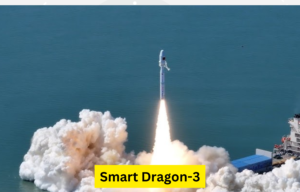China’s Smart Dragon-3 Sea Launch Marks a New Milestone in Space Technology

In September 2024, This event not only showcases China’s growing expertise in commercial space technology but also highlights its ambitions to dominate the global space industry. The launch took place from the Yellow Sea, further cementing China’s unique capability in maritime launches.
Smart Dragon-3: A New Player in Commercial Space Launches
The Smart Dragon-3 (SD-3), developed by the China Rocket Co., Ltd, a subsidiary of the state-owned China Academy of Launch Vehicle Technology (CALT), is designed to be an affordable, quick-response satellite launcher. It belongs to the Long March family of rockets, which has played a crucial role in China’s space endeavors.
Key Features of the Smart Dragon-3 Rocket:
- Height: 31 meters
- Mass: 116 tons
- Payload Capacity: The SD-3 is capable of carrying payloads of up to 1.5 metric tons to a 500 km low Earth orbit (LEO).
- Launch Platform: Sea-based platform, making it a versatile and cost-effective solution for satellite deployment.
What sets the Smart Dragon-3 apart is its rapid deployment capability. Unlike traditional ground-based launches, which require extensive infrastructure and preparation, the SD-3 can be launched from sea platforms, offering greater flexibility in selecting optimal launch locations and reducing the time between successive launches.
Sea Launch: A New Frontier for China’s Space Program
China’s decision to carry out this launch from the Yellow Sea represents a strategic shift toward maritime launches. This method offers several advantages, including:
- Geopolitical Flexibility: Launching from the sea eliminates the need for a fixed land-based facility and reduces potential political and environmental concerns associated with ground-based sites.
- Optimal Trajectories: A sea launch allows the rocket to be positioned closer to the equator, where the Earth’s rotational speed is highest, enabling more efficient launches.
- Safety: By launching over the ocean, any potential failure would result in minimal risk to populated areas.
The Yellow Sea was selected due to its strategic location and the infrastructure already in place, making it an ideal location for this launch.
The Payload: Expanding China’s Commercial Space Ambitions
The Smart Dragon-3 carried several satellites as part of its mission, marking another step in China’s commercial satellite launch market. The satellites will be used for various purposes, including Earth observation, communication, and remote sensing.
China is rapidly expanding its presence in the global satellite launch industry, with increasing demand from both domestic and international clients. The SD-3 is poised to become a key player in this market, offering reliable and cost-effective satellite deployment solutions.
China’s Growing Space Capabilities
China’s space program has grown exponentially over the past decade, with significant achievements in both crewed and uncrewed missions. From landing on the far side of the Moon to building its own space station, China is now seen as a major competitor to the United States and Russia in space exploration.
Recent Milestones in China’s Space Program:
- Tianhe Core Module: The launch of the first module of China’s Tiangong Space Station, which is now operational in low Earth orbit.
- Chang’e Lunar Missions: The Chang’e-5 mission successfully brought lunar samples back to Earth, making China the third country to do so.
- Mars Rover Zhurong: As part of the Tianwen-1 mission, China’s rover landed on Mars in May 2021, showcasing its growing interplanetary capabilities.
The successful launch of the Smart Dragon-3 represents another step toward China’s ambition of becoming a leader in space exploration and commercialization.
also read: Zomato Co-founder Akriti Chopra Resigns: What’s Next for the Food Delivery Giant?
Implications for Global Space Competition
The Smart Dragon-3’s success highlights China’s growing influence in the space industry. With affordable, reliable, and flexible launch capabilities, China is positioning itself as a major competitor in the lucrative global satellite launch market. This launch also signals China’s commitment to developing new and innovative solutions for space access.
Key Competitors in the Commercial Space Market:
- SpaceX: The leading commercial space company in the U.S., known for its reusable Falcon 9 rocket and ambitious plans to colonize Mars with its Starship program.
- Rocket Lab: A New Zealand-based company focused on small satellite launches using its Electron rocket.
- Arianespace: A European company offering commercial satellite launches, primarily with its Ariane rockets.
China’s entry into this competitive space shows that it is not content with being a secondary player—it aims to lead the way in both space exploration and commercial satellite deployment.
What’s Next for China’s Space Ambitions?
Looking ahead, China has even more ambitious plans in store. The country has announced its goal to build a lunar base in the coming decade and is actively working on missions that would send Chinese astronauts to the Moon. In the commercial sector, China Rocket Co., Ltd. is expected to continue developing more advanced rockets to meet the growing demand for space access.
The successful launch of the Smart Dragon-3 indicates that China is not only keeping pace with global space leaders but is also setting new benchmarks for innovation in satellite launch technology.





